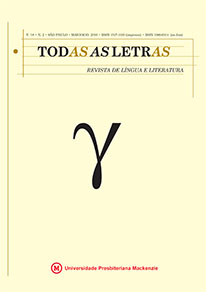Hearing “gay”:
prosody, interpretation, andtHeaffectivejudgmentsofmen’sspeecH
Abstract
This article describes a controlled experiment designed to determine what people listen to specifically when judging a speaker’s sexuality. four ex-perimental stimuli were produced by digitally shortening the syllable duration and narrowing the pitch of one male speaker reading a passage. Listeners rated various combinations of the four stimuli on ten affective scales, including straight/gay and effeminate/ masculine. Altering the two variables was insuffi-cient to alter listeners’ perceptions of the speaker’s sexuality to a level of signifi-cance. However, significant correlations between the different attitudinal scales illustrated that perceptions of sexuality are ideologically linked to other percep-tions of personality and personhood.
Downloads
References
BELL, A. Language style as audience design. Language in Society, v. 13, n. 2, p. 145-204, June 1984.
BELL, A. Back in style: reworking audience design. In: ECKERT, P.; RICKfORD, J. R. (Ed.). Style and sociolinguistic variation. Cambridge: Cambridge University Press, 2001. p. 139-69.
BUCHOLTz, M.; HALL, K. Theorizing identity in language and sexuality resear-ch. Language in Society, v. 33, n. 4, p. 469-515, Oct. 2004.
CAMERON, D.; KULICK, D. Language and sexuality. London: Cambridge Uni-versity Press, 2003.DERRIDA, J. Limited Inc. Evanston, Ill. Evanston: Northwestern University Press, 1995.
ECKERT, P. Demystifying sexuality and desire. In: CAMPBELL-KIBLER, K. et al. (Ed.). Language and sexuality: contesting meaning in theory and practice. Stan-ford: Center for the Study of Language and Information, 2002. p. 99-110.fRY, D. B. Experiments in the perception of stress. Language and Speech, v. 1, n. 2, p. 126-152, Apr./June 1958.
GAUDIO, R. P. Sounding gay: pitch properties in the speech of gay and straight men. American Speech, v. 69, n. 1, p. 30-57, Spring 1994.
GILES, H.; POWESLAND, P. f. A social psychological model of speech diversity. In: GILES, H.; POWESLAND, P. (Ed.). Speech style and social evaluation. New York: Harcourt Brace, 1975. p. 154-170.
HENTON, C. G. fact and fiction in the description of female and male pitch. Language & Communication, v. 9, n. 4, p. 299-311, 1989.
HENTON, C. G. Pitch dynamism in female and male speech. Language & Com-munication, v. 15, n. 1, p. 43-61, Jan. 1995
IRVINE, J. “Style” as distinctiveness: the culture and ideology of linguistic diffe-rentiation. In: ECKERT, P.; RICKfORD, J. R. Style and sociolinguistic variation. Cambridge: Cambridge University Press, 2001. p. 21-43.
JASSEM, W. On the pitch and compass of the speaking voice. Journal of Phone-tics, v. 1, n. 2, p. 59-68, 1971.
KLATT, D. H. The duration of [S] in English words. Journal of Speech and Hea-ring Research, v. 17, n. 1, p. 51-63, Mar. 1974.
KLATT, D. H. Vowel lengthening is syntactically determined in a connected dis-course. Journal of Phonetics, v. 3, n. 3, p. 129-140, July 1975.
KULICK, D. Gay and lesbian language. Annual Review of Anthropology, v. 29, p. 243-285, Oct. 2000.
LAMBERT, W. E. et al. Evaluational reactions to spoken languages. Journal of Abnormal and Social Psychology, v. 60, p. 44-51, Jan. 1960.
LEHISTE, I. Some factors affecting the duration of syllabic nuclei in English. In: DRACHMAN, G. (Ed.). Akten der 1: Salzburger frühlingstagung für Linguistik, Salzburg vom 24.bis25. Mai 1974. Tübingen: Narr, 1975. p. 81-104.
LEVON, E. Examining a gay prosody: issues in theory, methodology, and iden-tity. Paper presented at Lavender Languages and Linguistics XI, Washington, D.C., 2004.LINVILLE, S. E. Acoustic correlates of perceived versus actual sexual orienta-tion in men’s speech. Folia Phoniatrica et Logopaedica, v. 50, n. 1, p. 35-48, 1998.
NOOTEBOOM, S. The prosody of speech: melody and rhythm. In: HARDCAS-TLE, W. J.; LAVER, J. The handbook of phonetic sciences. Oxford: Blackwell, 1997. p. 640-673.
OLLER, D. K. The effect of position in utterance on speech segment duration in English. Journal of the Acoustical Society of America, v. 54, n. 5, p. 1235-1247, Nov. 1973.
PODESVA, R. “The stylistic use of phonation type: falsetto, fundamental fre-quency, and the linguistic construction of personae.” Unpublished MS. 2003.
PODESVA, R. J.; ROBERTS, S. J.; CAMPBELL-KIBLER, K. Sharing resources and indexing meaning in the production of gay styles. In: CAMPBELL-KIBLER, K. et al. (Ed.). Language and sexuality: contesting meaning in theory and prac-tice. Stanford: Center for the Study of Language and Information, 2002. p. 175-190.
RICH, A. Compulsory heterosexuality and lesbian existence. Signs: Journal of Women in Culture and Society, n. 5, p. 631-660, 1980.
ROGERS, H.; SMYTH, R. Phonetic differences between gay- and straight-soun-ding male speakers of North American English. In: INTERNATIONAL CON-GRESS Of PHONETIC SCIENCES, 15., Barcelona, 2003. Proceedings... Barce-lona: Universitat Autònoma de Barcelona, 2003. p. 1855-1858.
ROGERS, H.; SMYTH, R.; JACOBS, G. Vowel and sibilant duration in gay- and straight-sounding male speech. In: International Gender and Language Asso-ciation Conference, 1., 2000, Stanford. Papers... Stanford, 2000.
SCHERER, K. R. Judging personality from voice: a cross-cultural approach to an old issue in interpersonal perception. Journal of Personality, v. 40, n. 2, p. 191-210, June 1972.
SMYTH, R.; JACOBS, G.; ROGERS, H. Male voices and perceived sexual orien-tation: an experimental and theoretical approach. Language in Society, v. 32, n. 3, p. 329-350, June 2003.
UMEDA, N. Consonant duration in American English. Journal of the Acoustical Society of America, v. 61, n. 3, p. 846-858, Mar. 1977.
VALENTINE, D. “I went to bed with my own kind once”: the erasure of desire in the name of identity. Language & Communication, v. 23, n. 2, p. 123-138, Apr. 2003.
Downloads
Published
How to Cite
Issue
Section
License
Copyright (c) 2016 Todas as Letras - Revista de Língua e Literatura

This work is licensed under a Creative Commons Attribution-NonCommercial 4.0 International License.
The originals accepted and published become property of Mackenzie Presbyterian University, being forbidden their total or partial reproduction without permission of the Editorial Board, except for study and research.




